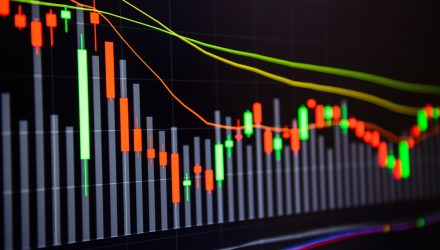The CBOE Volatility Index and VIX-related exchange traded funds surged Thursday as gripping fears of another economic shut down in face of renewed coronavirus outbreaks fueled market anxiety.
VIX-related strategies were among the best performing non-leveraged ETFs of Thursday. The iPath Series B S&P 500 VIX Short Term Futures ETN (NYSEArca: VXX) increased 34.0%, ProShares VIX Short-Term Futures ETF (NYSEArca: VIXY) advanced 34.0% and VelocityShares Daily Long VIX Short-Term ETN (NYSEArca: VIIX) jumped 33.7% while the CBOE Volatility Index rose to 51.3, hovering around its highest level since late April. The VIX and related exchange traded products also crossed back above their short-term resistance at the 50-day simple moving average. Potential investors should keep in mind that VIX-related ETPs track VIX futures and not the spot price.
Volatility typically rises when stocks pullback, so owning volatility is seen as a type of market insurance. The VIX, or so-called fear gauge, is an instrument created by the Chicago Board Options Exchange (CBOE), a real-time market index that represents the market’s expectation of a month period of forward-looking volatility. In most cases, the higher the volatility, the riskier the security.
The VIX climbed Thursday in response to swift broad equity pullback with the S&P 500 down 5.8% to 3,005 toward the end of the day while the Dow Jones Industrial Average gave up more than 1,800 points.
Dragging on market sentiment, the number of U.S. coronavirus infections crossed over the two million mark with over 112,000 American deaths, according to Johns Hopkins University. the seven-day average of new cases over the last two weeks is still rising in over 20 states, fueling fears about a second wave of the epidemic just as business activity is resuming, MarketWatch reports.
Further adding to the risk-off sentiment, the Federal Reserve’s updated policy statement revealed a projected 6.5% contraction by the end of the year on a year-over-year basis with an unemployment rate of 9.3%.
“The stock market has almost had blinders on,” Kristina Hooper, Invesco chief global market strategist, told MarketWatch. “More than one in three companies in the S&P 500 are dispensing with earnings guidance. So investors have anchored to data, which has been relatively positive about reopenings in various states, improvements in PMIs, and the jobs report last week. In one fell swoop, Jay Powell threw a lot of cold water on that narrative.”
For more information on the markets, visit our current affairs category.








